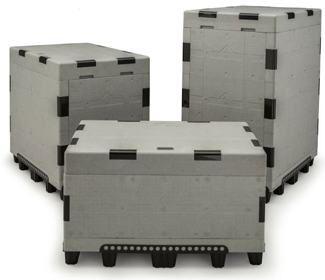 The Phase Change Matters e-mail newsletter is a weekly summary of the latest news and research on phase change materials and thermal energy storage. To subscribe, visit www.puretemp.com/subscribe. For more frequent updates, follow @puretemp on Twitter or visit the Phase Change Matters blog, www.puretemp.com/pcmatters.
The Phase Change Matters e-mail newsletter is a weekly summary of the latest news and research on phase change materials and thermal energy storage. To subscribe, visit www.puretemp.com/subscribe. For more frequent updates, follow @puretemp on Twitter or visit the Phase Change Matters blog, www.puretemp.com/pcmatters.
BUILDING | CONSTRUCTION
Work continues on effort to add PCM products to California energy code
At its meeting earlier this month, the RAL Quality Association PCM discussed an update on an initiative to include phase change material in the Building Efficiency Standards contained in the California Code of Regulations.
The update, provided by Jeremiah Crossett, chief technology officer of NRGsim Inc., outlined the initiative’s timeline and cost projections.
 Crossett is developing a database of PCM products and performing a detailed modeling study on a variety of PCM products in all California climate zones. The goal is to build a persuasive case for including PCMs in the next version of the standards, to be published in 2019.
Crossett is developing a database of PCM products and performing a detailed modeling study on a variety of PCM products in all California climate zones. The goal is to build a persuasive case for including PCMs in the next version of the standards, to be published in 2019.
Manufacturers of PCM building products are invited to submit products to Crossett for inclusion in the database. One or two products can be submitted for $2,000; an unlimited number can be submitted for $5,000. For Crossett’s modeling study, $2,000 covers one or two products; $5,000 covers an unlimited number.
Crossett hopes to complete work on the initiative by next winter. Insolcorp, which installs PCM building products in California, Nevada and other states, has been covering the costs. Crossett asked if any members of the RAL Quality Association PCM would be interested in co-funding the initiative. Members suggested that the new PCM Industry Association of North America would be a better audience for that question. Companies interested in participating can contact Crossett at jcrossett@nrgsim.com.
PATENTS
Wearable temperature control garment system
U.S. patent application 20180070659 (inventor Peng Xu, Moraga, Calif.):
“A wearable air temperature control system has two separable parts, a garment and an external heat pump, and the two parts are connected together via a connecting tube. The garment comprises an inner layer, a middle layer which is a carrier supporting the PCM capsules, and an insulating layer. The three layers [are] secured together to form a laminated unitary structure, which is flexible, soft and breathable. The external heat pump circulates cold or hot water through the garment when the garment is connected. The water flows in the capillary tube embedded in the PCM capsules and recharge the PCM. As a result, the garment could achieve cooling or heating by melting or freezing the PCM material inside the PCM capsules, whether the garment is separated from or connected to the heat pump for recharging. After the garment is fully recharged, the garment can be disconnected from the heat pump which allows wearers to move or work easily outdoors only wearing the portable garment.”
IN BRIEF
• Energy and Buildings has issued a call for papers for a special issue on energy storage for building applications. Topics include “bio-inspired, bio-based, and bio-replicated storage materials and systems,” “storage-based systems for mitigating indoor-outdoor microclimate” and “smart, multipurpose, multifunctional materials for sensible and latent thermal energy storage in buildings.” Dr. Luisa F. Cabeza of the University of Lleida is among the issue’s guest editors. Papers will be accepted between May 1 and July 31. Original manuscripts only.
• Nebuma of Saarbrücken, Germany, has introduced a thermal energy storage system that can store around 16MWh of heat in a 20-foot container. The company says the blocks or granules in the tanks can be heated to up to 1,300ºC “with an efficiency that is second to none.”
 • Peli BioThermal unveiled a new addition to its range of bulk temperature-control shippers this week at Clinical Trial Supply Europe in Milan. The CoolPall Flex is available in three heights with a capacity range of 140 to 767 liters. Options include standard insulation or vacuum insulated panels and water-based or PCM coolants in single or double coolant configurations.
• Peli BioThermal unveiled a new addition to its range of bulk temperature-control shippers this week at Clinical Trial Supply Europe in Milan. The CoolPall Flex is available in three heights with a capacity range of 140 to 767 liters. Options include standard insulation or vacuum insulated panels and water-based or PCM coolants in single or double coolant configurations.
• Harvard University‘s new district energy facility will feature the largest thermal storage tank in Massachusetts. The 1.3-million-gallon tank will store chilled water that will be used to cool buildings. It will also support some limited research applications.
• New from Pike Research: “Revenue From Net Zero Energy Buildings to Reach $1.3 Trillion by 2035“
• New from HeyReport: “2015-2023 World Micro-capsule Phase Change Composite Material Market Research Report by Product Type, End-User / Application and Regions / Countries”
• New from HTF Market Intelligence: “Phase Change Materials Market Overview – Key Futuristic Trends and Competitive Landscape 2023“
• New from Transparency Market Research: “Cold Chain Packaging Market – Global Industry Analysis, Size, Share, Growth, Trends, and Forecast 2017 – 2025”
• Ice Energy has announced the launch of “Keep Your Cool,” a free HVAC replacement and energy storage program in Orange County, Calif. Under the program, qualifying businesses are eligible to receive fully installed HVAC and thermal energy storage systems, using Ice Energy’s proprietary Ice Bear unit. The system freezes water at night when demand for power is low. The stored ice is then used during the peak period of the day to provide uninterrupted cooling, using less energy and reducing air conditioning bills by up to 40 percent.
RESEARCH ROUNDUP
For our full list of recent academic research, see puretemp.com/academic. Here are highlights from the past week:
From International Journal of Refrigeration:• Enhancing the Thermosiphon-Driven Discharge of a Latent Heat Thermal Storage System used in a Personal Cooling Device
• An Overview of Current Status of Cold Chain in China
From Energy & Fuels:
• Preparation and Characterization of Modified Porous Wood Flour/Lauric-Myristic Acid Eutectic Mixture as a Form-Stable Phase Change Material
From Institut International du Froid:
• A novel phase based cooling system for prismatic lithium ion batteries
From Solar Energy:
• Optimization of solar photovoltaic system integrated with phase change material
• A novel heat transfer enhancement technique for performance improvements in encapsulated latent heat storage system
• Experimental and numerical investigation of a solar collector/storage system with composite phase change materials
From Solar Energy Materials and Solar Cells:
• Enhanced thermal conductivity of phase change material nanocomposites based on MnO2 nanowires and nanotubes for energy storage
From Handbook of Thermal Analysis and Calorimetry:
• Applications of Thermal Analysis to the Study of Phase-Change Materials
From Thermochimica Acta:
• Thermo-physical characteristics, mechanical performance and long-term stability of high temperature latent heat storages based on paraffin-polymer compounds
From Applied Energy:
• High thermal conductive paraffin/calcium carbonate phase change microcapsules based composites with different carbon network
NETWORKING
Connect with PCM experts and industry leaders on LinkedIn
 More than 1,200 people have joined a LinkedIn group devoted to the discussion of phase change material and thermal energy storage. The Phase Change Matters group is an interactive complement to the award-winning blog and newsletter of the same name.
More than 1,200 people have joined a LinkedIn group devoted to the discussion of phase change material and thermal energy storage. The Phase Change Matters group is an interactive complement to the award-winning blog and newsletter of the same name.
You are invited to join the group and connect with PCM and TES experts from around the world. This week we welcome Egon Schmitz of Axiotherm GmbH, Eisenberg, Germany; Kevin Stalter, president of Zebco Industries Inc., Lancaster, Ohio; Robert Craven, R&D engineer at Tennessee Technological University, Cookeville, Tenn.; Marcel Christians, chief technology officer at Ice Energy, Orange County, Calif.; and Luke Mahony, manager of Earth Dwellings Australia Pty. Ltd., Pacific Palms, Australia.